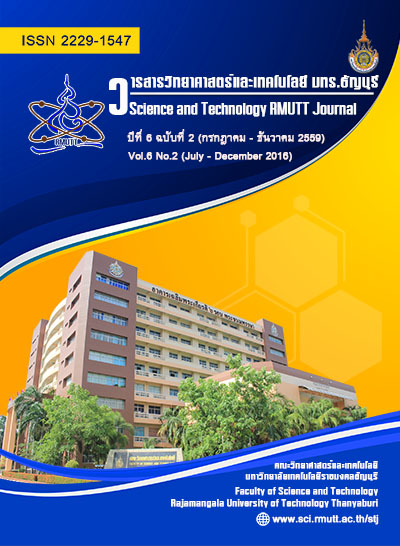Application of Chitosan and Rice Straw Extract to Inhibit Growth of Microcystis spp. in Experimental Ponds
Main Article Content
Abstract
This research focuses on the elimination of algal Microcystis spp. using chitosan and rice straw extract together. These compounds can inhibit the growth of algal species. It is safe when applied and does not cause any adverse effects on the environment. Two experiment ponds were used in this study. The first experiment pond studied non-concentrations of chitosan and rice straw extract. The second experiment pond studied chitosan and rice straw extract at ratio 3:1. Samples were analyzed algal cell and water quality. The result showed that algal cells of Microcystis spp. were reduced by 75.89 %. Considering the quality of surface water showed that Dissolved Oxygen was increased 1.7 mg/l. Biochemical Oxygen Demand was increased up to 0.2 mg/l. Total Dissolved Solids was reduced 39.1%. The levels did not exceed the quality standards for surface water. Three types of nutrients namely ammonia-nitrogen was decreased 74.39%. Orthophosphate was decreased 35.4%. Nitrate-nitrogen was decreased 36.82%. The difference among the experiment’s datas were statistically significant (p<0.05.).
Article Details
References
น. สหนาวิน, จ. ตอฤทธิ์. ปรากฏการณ์ยูโทรฟิเคชัน (Eutrophication).วารสารคณะพลศึกษา. 15 (ฉบับพิเศษ) (2555): 154-159.
ส. พงษ์สวัสดิ์, ส. สุพรรณ, ว. แฉ่งประเสริฐ. การศึกษาประสิทธิภาพและผลกระทบของการใช้สารคอปเปอร์ซัลเฟต ในการกำจัดสาหร่ายพิษในแหล่งน้ำของกองทัพอากาศ ณ ที่ตั้งดอนเมือง. วารสารวิทยาศาสตร์บูรพา. 18 (2556): 153-165.
ย. พีรพรพิศาล. สาหร่ายวิทยา (Phycology). เชียงใหม่: สำนักพิมพ์มหาวิทยาลัยเชียงใหม่. 2549.
ประกาศคณะกรรมการสิ่งแวดล้อมแห่งชาติ ฉบับที่ 8. เรื่อง กำหนดคุณภาพน้ำในแหล่งน้ำผิวดิน. (2537, 24 กุมภาพันธ์). ราชกิจจานุเบกษา. เล่มที่ 111 ตอนที่ 16ง. 2537.
ประกาศคณะกรรมการสิ่งแวดล้อมแห่งชาติ ฉบับที่ 25. เรื่อง กำหนดมาตรฐานคุณภาพดิน. (2547, 20 ตุลาคม). ราชกิจจานุเบกษา. เล่มที่ 121 ตอนพิเศษ 119ง. 2547.
ประกาศคณะกรรมการสิ่งแวดล้อมแห่งชาติ เรื่อง กำหนดมาตรฐานควบคุมการระบายน้ำทิ้งจากอาคารบางประเภทและบางขนาด. (2548, 7 พฤศจิกายน).ราชกิจจานุเบกษา.เล่มที่ 122 ตอนที่ 125ง. 2548.
ภ. เมธะคานนท์, อ. เฟื่องฟูชาติ, ก. คงสุวรรณ. ความรู้เบื้องต้นเกี่ยวกับ ไคติน-ไคโตซาน. เอ็มเทค เทคโนโลยีวัสดุ. 2543.
ศูนย์เทคโนโลยีโลหะและวัสดุแห่งชาติ. เรื่องน่ารู้ไคติน-ไคโตซาน. จุฬาลงกรณ์มหาวิทยาลัย. กรุงเทพฯ. 2546.
นิรนาม. การไถกลบตอซังเพื่อปรับปรุงดินและเพิ่มผลผลิตข้าว. กลุ่มระบบงานวิจัย กองแผนงาน ร่วมกับกลุ่มวิจัยและพัฒนาอินทรียวัตถุเพื่อการเกษตร สำนักวิจัยและพัฒนาการจัดการที่ดิน. 2554.
K.N. Aye, W.F. Stevens. Improved Chitin production by pretreatment of shrimp shells. Chem. Technol Biotech. 79 (2004): 421-425.
Q. Yan, Y. Yuhe, F. Weisong, P. Gang. Plankton Community Succesion in Artificial Systems Subjected to Cyanobacterial Blooms Removal using Chitosan-Modified Soils. Microb Ecol. 58 (2009): 47-55.
B.S. Andreas, D. Sarah. Chitosan-based drug delivery systems Pharmaceutics and Biopharmaceutics dextrans of controlled size using engineered dextransucrase. Biocat Biotrans. 26 (2012): 463-469.
G. Pan, B. Yang, D. Wang, H. Chen, B. Tian, M. Zhang, X. Yuan, J. Chen. In-lake algal bloom removal and submerged vegetation restoration using modified local soils. Ecol Engin. 37 (2011): 302–308.
N. Chaosuan, S. Pongswat, S. Supan. “Removal of Microcystis spp. by Chitosan and Rice Straw
Extract”. in The International Conference on Science and Technology (TICST 2015). Pathumthani, Thailand. 2015. 256-265.
A.S. Ball, M. Williams, D. Vincent, J. Robinson. Algal growth control by a barley extract. Bio Technol. 77 (2001): 177–181.
M.H. Park, M.S. Han, C.Y. Ahn, H.S. Kim, B.D. Yoon, H.M. Ho. Growth inhibition of bloom-forming cyanobacterium Microcystis aeruginosa by rice straw extract. Appl Microb. 43 (2006): 377-312.
P.R.F.Barrett, J.C. Curnow, J.W. Littlejohn. The control of diatom and cyanobacterial blooms in reservoirs using barley straw. Hydrobiol. 340 (1996): 307–311.
E.L. Rice, C.Y. Lin, C.Y. Huang. Effects of decaying rice straw on growth and nitrogen fixation of a bluegreen alga. Bot. Bull. Acadimia Sinica. 21 (1980): 111–117.
M.H. Park, I.M. Chung, A. Ateeque, B.H. Kim, S.J. Hwang. Growth inhibition of unicellular and colonial Microcystis strains (Cyanophyceae) by compounds isolated from rice (Oryza sativa) hulls. Aqua Bot. 90 (2009): 309–314.
I.M. Welch, P.R.F. Barrett, M.T. Gibson, I. Ridge. Barley straw as an inhibitor of algal growth I: studies in the Chesterfield Canal. Appl Phyco. 2 (1990): 231–239.
I. Ridge, J.M. Pillinger. Towards understanding the nature of algal inhibitors from barley straw. Hydrobiol. 340 (1996): 301–305
X. Xi, Y. Chen, X. Liang, L. Lou, X. Tang.. Effects of Tibetan hulless barley on bloomforming cyanobacterium (Microcystis aeruginosa) measured by different physiological and morphologic parameters. Chem. 81 (2010): 1118-1123.
H. Pei, C.X. Ma, W.R. Hu, F. Sun. The behaviors of Microcystis aeruginosa cells and extracellular microcystins during chitosan flocculation and flocs storage processes. Bio Technol. 151 (2014): 314–322.
M.T. Gibson, I.M. Welch, P.R.F. Barrett, I. Ridge. Barley straw as an inhibitor of algal growth II: laboratory studies. Appl Phyco. 2 (1990): 241–248.
A.K. Lam, E.E. Prepas, D. Spink, S.E. Hrudey. Chemical control of hepatotoxic phytoplankton blooms: implications for human health. Water Res. 29 (1995): 1845–1854.
S.R. Carpenter, D. Ludwig, W.A. Brock. Management of eutrophication for lakes subject to potentially irreversible change. Ecol. Appl. 9 (1999): 751–771.
S.R. Carpenter. Phosphorus control is critical to mitigating eutrophication. Proc. Natl. Acad. Sci. U.S.A. 105 (2008):11039–11040.
X. Jin, C. Zhaosheng, Y. Feng, Z. Qingru. Effects of lanthanum (III) and EDTA on the growth and competition of Microcystis aeruginosa and Scenedesmus quadricauda. Limnol. 39 (2009): 86–93.
G. Mulderij, W.M., Mooij, A.J.P. Smolder, D.E. Van. Allelopathic inhibition of phytoplankton by Stratiotes aloides. Aqua bot. 82 (2005): 284-296.
A. Guzzon, A. Bohn, M. Diociaiuti, P. Albertano. Cultured phototrophic biofilms for phosphorus removal in wastewater treatment. Water Res. 42 (2008): 4357–4367.
M. D. Greca, P. Monaco, A. Pollio, L. Previtera. Structure-activity relationships of penylpropanoids as growth inhibitors of the green alga Selenastrum capricornutum. Phytochem . 31 (1992): 4119–4123.
D. Planas, F. Sarhan, L. Dube, H. Godmaire, C. Cadieux. Ecological significance of phenolic compounds of Myriophyllum spicatum. Verh. Internat. Verein. Limnol. 21 (1981): 1492–1496.
S. Miyachi, I. Iwasaki, Y. Shiraiwa, S. Yoshihiro. Historical perspective on microalgal and cyanobacterial acclimation to low and barnyard grass. Agron. 24 (2004): 1162–1167.
T.G. Shu, B.L. Yuan, S.R. Wang. Studies on the removal of Mircocystis aeruginosa by low-power ultrasonic. Huaqiao Univ. (Nat. Sci.). 29 (2008): 72–75.
K. Spiros, S. Antje, P. Michiel. Sonic cracking of blue-green algae. Appl.Acoust. 70 (2009): 1306–1312.
APHA, AWWA & WPCF. Standard methods for the examination of water and wastewater. 19th ed. Washington D.C.: American Public Health Association. 1992.
S. Lochmatter, C. Holliger. Optimization of operation conditions for the startup of aerobic granular sludge reactors biologically removing carbon, nitrogen, and phosphorous. Water Res. 59 (2014): 58–70.


